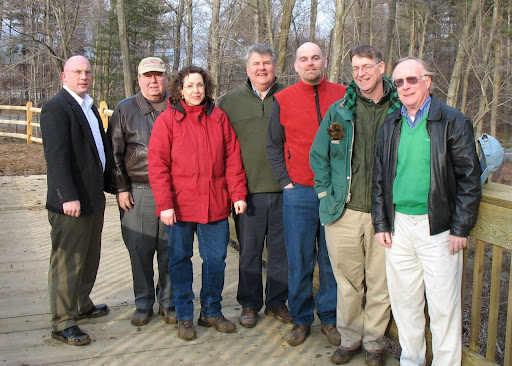http://sheltonherald.com/22430/commentary-lauretti-land-deal-an-example-of-citywide-shell-game/
I can't recall reading such a commentary filled with so many inaccuracies.
+++
Let’s discuss the latest accomplishments of our mayor while maintaining a low tax base for the city. While he touts low taxes, a given few have lined their pockets by very coyly using a shell game.
Example: Some time ago the property that Mayor Mark Lauretti just sold on River Road was offered to the city for much less than what the mayor paid for it.
+++
This above statement is not factual. The property (assume this means 550 River Road) was never offered to the City of Shelton to my knowledge. Any offer of sale would have been dealt with in executive session, but having served on the Conservation Commission for years previous when the property was owned by Emhart Fasteners, I never saw nor heard of any such offer.
+++
The open lands committee said it was not interested because the land did not connect to the property they were looking at, between downtown and the Huntington Green. It could not be connected to the path going from downtown to Huntington Center through the swamps of Shelton’s back woods (shell game).Example: Some time ago the property that Mayor Mark Lauretti just sold on River Road was offered to the city for much less than what the mayor paid for it.
They felt creating the path was more desirable than the pristine riverfront property, with its water views and what could have been a beautiful beach for residents.
+++
The Conservation Commission is the one that reviews Open Space potentials. At one time there was an "Open Space Committee" which developed a "Quality of Life" list of potential acquisition parcels. This list of specific parcels did not include 550 River Road. The list of parcels was not an exclusive list for acquisition, merely ones that required focus. Potential acquisition parcels are typically along Greenway Corridors as outlined in the Open Space Plan document, but certain parcels were either at risk or offered timely opportunity to be acquired.
The path through the "swamps" that is referred to as a "shell game" is the Shelton Lakes Recreation Path, which was a consistent and persistent project of the Conservation Commission for 20 years, both in acquisition of parcels in the Shelton Lakes Greenway and Far Mill River Greenway, and the numerous grants, funding, volunteer work parties and contractor management to accomplish the RecPath's construction.
There was no contrast or comparison between a Shelton Lakes Rec Path in one end of town and a piece of property in another part of town. Nothing was "more desirable" than a riverfront property, which was contaminated with metal hydroxide sludge from previous manufacturing activity, and offered no "beach" potential given the limited access pinch point next to a tidal lagoon. The writer's portrayal of a "pristine riverfront property" is not accurate.
+++
Advising the public on this issue
I ask you, why weren’t the people of Shelton advised of this issue when it came up rather than after the fact (shell game)?
+++
The writer displays a complete non-understanding of the purchase of land process through municipal government (not just Shelton). I repeat, that the City of Shelton was never offered the property of 550 River Road previous to the Mayor's purchase, and if they had been offered it, the Conservation Commission would repeat consistency as it has done with other parcels offered, to avoid purchasing Open Space parcels that have environmental contamination.
+++
At the time of purchase, the mayor made a deal for a large part of the property to be subdivided because that portion was contaminated. The mayor did not want to have to deal with the expense of a cleanup.
+++
On this aspect, there is a discussion that should be had. The division of 550 River Road into two separate parcels, one of which was land-locked and contained environmental contamination, has been termed by officials as an "inappropriate subdivision". The property was not "free split" and the property did not have a subdivision application, yet somehow became multiple parcels of land during a map filing. How this can happen has not been explained to me.
+++
Oh, by the way, that’s the portion that the new owner will provide as a buffer. Keep in mind no citizen will be allowed to cross that property to the river because it is contaminated.
+++
The recently approved application by the Planning & Zoning Commission included an Open Space dedication in the form of a conservation easement, and public access in form of a pedestrian easement. Neither involved the parcel of land which has a significant contamination area that is "capped" in place, and thus remains off-limits to any access by persons. This contaminated parcel is immediately adjacent to the area being developed for residential living.
+++
Meanwhile, the zoning board just placed a roadblock for a developer by delaying a zone change on a Bridgeport Avenue property because the downtown development committee showed it would harm the plan for downtown improvements already in the works.
+++
While the Planning & Zoning "Commission" did not approve a recent application on Bridgeport Avenue that included a zone change for residential use in a commercial zone via a PDD (Planned Development District) method, saying that the Commission was "delaying" a zone change implies that they will be approving the zone change at a future date, which there has been no indication for, and which I personally hope will not occur in the future in any form, because I believe that to be a inappropriate direction for the City's long term health via providing for the ability to amply grow the tax base.
+++
How come we did not hear from this committee on the zone change for the mayor’s land?
+++
That sentence is not even remotely in touch with reality. Do a google search on the query term "550 River Road" with the restriction of site:cityofshelton.org and you will find all the information regarding applications, zone changes, reviews, not only by the Planning & Zoning Commission, but the Inland Wetlands Commission, and the Conservation Commission.
+++
Fear of rocking the boat
People in this town will talk about these issues amongst each other but for some reason no one will come forward for fear of rocking the boat at City Hall, resulting in higher taxes.
Why the people of Shelton have allowed this shell game to get so bad is beyond explanation. It’s time people bring it out in the open and do what’s best for all in Shelton.
Mr. Mayor, you did what most land-grabbing politicians (excuse me, that should be “public servants”) do and you have come out smelling like a rose.
You made $1.6 million. And the city loses water access of any kind on a riverfront property, downtown revitalization suffers, and hopes of improved services for residents in return for taxes paid are dashed.
+++
The development application approved for 550 River Road includes a conservation easement and pedestrian easement that achieves access to the water by the public. It includes protections on the buffer zone of the Butternut Hollow Brook, Ivy Brook, and Housatonic River. Significant water access is provided by the nearby Open Space known as "Southbank" which is just south of the location, and which includes ample street level parking as well as a pavilion for shelter.
+++
Shelton citizens, there are more issues to this then just a low tax base.
People, please wake up and smell the skunk weed in this town or we will be overrun by the swamp land we have built our scenic walking trail on.


